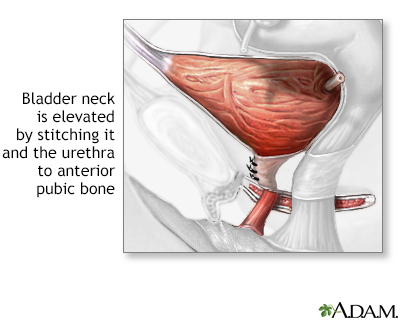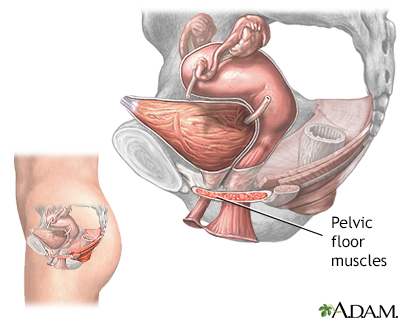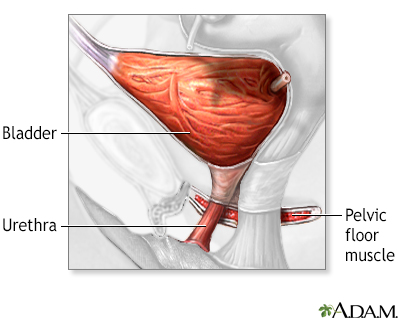Stress urinary incontinence
Incontinence - stress; Bladder incontinence stress; Pelvic prolapse - stress incontinence; Stress incontinence; Leakage of urine - stress incontinence; Urinary leakage - stress incontinence; Pelvic floor - stress incontinence
Stress urinary incontinence occurs when your bladder leaks urine during physical activity or exertion. It may happen when you cough, sneeze, lift something heavy, change positions, or exercise.

When you enter a store or restaurant, are you often looking to find the establishments bathroom? If you're having trouble holding in your urine, or if you often leak urine, you probably have what's called urinary incontinence. Normally, the bladder begins to fill with urine from the kidneys. The bladder stretches to allow more and more urine. You should feel the first urge to urinate when there is about 200 mL, just under 1 cup of urine stored in your bladder. A healthy nervous system will respond to this stretching sensation by letting you know that you have to urinate. But, at the same time, the bladder should keep filling. But the system doesn't work correctly in people with urinary incontinence. Some people with urinary incontinence leak urine during activities like coughing, sneezing, laughing, or exercise. This is called stress incontinence. When you have a sudden, strong need to urinate, but can't make it to the bathroom before you do urinate, it's called urge incontinence. Other people have what's called overflow incontinence, when the bladder cannot empty and they dribble. Urinary incontinence can have many causes, and it's most common in older adults. Women are more likely than men to have it. For some people the bladder muscle is overactive. For others, the muscles holding the urine in are weak. And for others, the problem is sensing when the bladder is full. They might have brain or nerve problems, dementia or other health problems that make it hard to feel and respond to the urge to urinate, or problems with the urinary system itself. To treat urinary incontinence, your doctor can help you form a treatment plan. Most likely, exercises to strengthen the muscles of your pelvic floor will be part of that plan. Bladder training exercises can also be effective. And depending on the cause of incontinence, oral medications, or topical estrogen may be helpful. If you have overflow incontinence and cannot empty your bladder completely, you may need to use a catheter. Your doctor can recommend the best catheter for you. For urine leaks, you might wear absorbent pads or undergarments. Whatever else you try, lifestyle changes may help. Aim for an ideal weight. Losing excess weight and increasing exercise both often improve incontinence, especially in women. Also, some specific beverages and foods might increase leaking in some people. For instance, you might try eliminating alcohol, caffeine, carbonated beverages, even decaf coffee. Drink plenty of water, but do NOT drink anything 2 to 4 hours before going to bed. Be sure to empty your bladder before going to bed to help prevent urine leakage at night. Throughout the day, urinate at set times, even if you do not feel the urge. Schedule yourself every 3 to 4 hours. Urinary incontinence is very common, but many people never talk to their doctor about it. Don't let that be you. See your doctor and bring it up at your next doctor's visit.

The female and male urinary tracts are relatively the same except for the length of the urethra.

The male and female urinary tracts are relatively the same except for the length of the urethra.

Retropubic suspension is a surgical technique used to improve urinary continence. In the procedure the bladder neck and urethra within the pelvic region are elevated and stitched to the pubic bone.

Stress incontinence is an involuntary loss of control of urine that occurs at the same time abdominal pressure is increased as in coughing or sneezing. It develops when the muscles of the pelvic floor have become weak.

Bladder and urethral repair is usually performed to prevent urine leakage associated with stress incontinence. Stress incontinence is the involuntary leakage of urine when laughing, coughing, sneezing, or lifting, which can result from deformity or damage to the urethra and bladder from decreased muscle tone caused by multiple births, menopause, or other causes.

Cystoscopy is a procedure that uses a flexible fiber optic scope inserted through the urethra into the urinary bladder. The physician fills the bladder with water and inspects the interior of the bladder. The image seen through the cystoscope may also be viewed on a color monitor and recorded on videotape for later evaluation.
When you enter a store or restaurant, are you often looking to find the establishments bathroom? If you're having trouble holding in your urine, or if you often leak urine, you probably have what's called urinary incontinence. Normally, the bladder begins to fill with urine from the kidneys. The bladder stretches to allow more and more urine. You should feel the first urge to urinate when there is about 200 mL, just under 1 cup of urine stored in your bladder. A healthy nervous system will respond to this stretching sensation by letting you know that you have to urinate. But, at the same time, the bladder should keep filling. But the system doesn't work correctly in people with urinary incontinence. Some people with urinary incontinence leak urine during activities like coughing, sneezing, laughing, or exercise. This is called stress incontinence. When you have a sudden, strong need to urinate, but can't make it to the bathroom before you do urinate, it's called urge incontinence. Other people have what's called overflow incontinence, when the bladder cannot empty and they dribble. Urinary incontinence can have many causes, and it's most common in older adults. Women are more likely than men to have it. For some people the bladder muscle is overactive. For others, the muscles holding the urine in are weak. And for others, the problem is sensing when the bladder is full. They might have brain or nerve problems, dementia or other health problems that make it hard to feel and respond to the urge to urinate, or problems with the urinary system itself. To treat urinary incontinence, your doctor can help you form a treatment plan. Most likely, exercises to strengthen the muscles of your pelvic floor will be part of that plan. Bladder training exercises can also be effective. And depending on the cause of incontinence, oral medications, or topical estrogen may be helpful. If you have overflow incontinence and cannot empty your bladder completely, you may need to use a catheter. Your doctor can recommend the best catheter for you. For urine leaks, you might wear absorbent pads or undergarments. Whatever else you try, lifestyle changes may help. Aim for an ideal weight. Losing excess weight and increasing exercise both often improve incontinence, especially in women. Also, some specific beverages and foods might increase leaking in some people. For instance, you might try eliminating alcohol, caffeine, carbonated beverages, even decaf coffee. Drink plenty of water, but do NOT drink anything 2 to 4 hours before going to bed. Be sure to empty your bladder before going to bed to help prevent urine leakage at night. Throughout the day, urinate at set times, even if you do not feel the urge. Schedule yourself every 3 to 4 hours. Urinary incontinence is very common, but many people never talk to their doctor about it. Don't let that be you. See your doctor and bring it up at your next doctor's visit.
Causes
Stress incontinence occurs when the tissue that supports your urethra gets weak.
- The bladder and urethra are supported by the pelvic floor muscles. Urine flows from your bladder through your urethra to the outside.
- The sphincter is a muscle around the opening of the bladder. It squeezes to prevent urine from leaking through the urethra.
When either set of muscles become weak, urine can pass when pressure is placed on your bladder. You may notice it when you:
- Cough
- Sneeze
- Laugh
- Exercise
- Lift heavy objects
- Have sex
Weakened muscles may be caused by:
- Childbirth
- Injury to the urethra area
- Some medicines
- Surgery in the pelvic area or the prostate (in men)
- Being overweight
- Unknown causes
Stress incontinence is common in women. Some things increase your risk, such as:
- Pregnancy and vaginal delivery.
- Pelvic prolapse. This is when your bladder, urethra, or rectum slide into the vagina. Delivering a baby can cause nerve or tissue damage in the pelvic area. This can lead to pelvic prolapse months or years after delivery.
Symptoms
The main symptom of stress incontinence is leaking urine when you:
- Are physically active
- Cough or sneeze
- Exercise
- Stand from a sitting or lying down position
Exams and Tests
Your health care provider will perform a physical exam. This will include:
- Genital exam in men
- Pelvic exam in women
- Rectal exam
Tests may include:
- Cystoscopy to look inside the bladder.
- Pad weight test: You exercise while wearing a sanitary pad. Then the pad is weighed to find out how much urine you lost.
- Voiding diary: You track your urinary habits, leakage and fluid intake.
- Pelvic or abdominal ultrasound.
- Post-void residual (PVR) to measure the amount of urine left after you urinate.
- Urinalysis to check for urinary tract infection.
- Urinary stress test: You stand with a full bladder and then cough.
- Urodynamic studies to measure pressure and urine flow.
- X-rays with contrast dye to look at your kidneys and bladder.
Treatment
Treatment depends on how your symptoms affect your life.
There are 3 types of treatment for stress incontinence:
- Behavior changes and bladder training
- Pelvic floor muscle training
- Surgery
There are no medicines for treatment of stress incontinence. Some providers may prescribe a medicine called duloxetine. This medicine is not approved by FDA for the treatment of stress incontinence.
BEHAVIOR CHANGES
Making these changes may help:
- Drink less fluid (if you drink more than normal amounts of fluid). Avoid drinking water before going to bed.
- Avoid jumping or running.
- Take fiber to avoid constipation, which can make urinary incontinence worse.
- Quit smoking. This can reduce coughing and bladder irritation. Smoking also increases your risk for bladder cancer.
- Avoid alcohol and caffeinated drinks such as coffee. They can make your bladder fill up quicker.
- Lose excess weight.
- Avoid foods and drinks that may irritate your bladder. These include spicy foods, carbonated drinks, and citrus.
- If you have diabetes, keep your blood sugar under good control.
BLADDER TRAINING
Bladder training may help you control your bladder. The person is asked to urinate at regular intervals. Slowly, the time interval is increased. This causes the bladder to stretch and hold more urine.
PELVIC FLOOR MUSCLE TRAINING
There are different ways to strengthen the muscles in your pelvic floor.
- Biofeedback: This method can help you learn to identify and control your pelvic floor muscles.
- Kegel exercises: These exercises can help keep the muscle around your urethra strong and working well. This may help keep you from leaking urine.
- Vaginal cones: You place the cone into the vagina. Then you try to squeeze your pelvic floor muscles to hold the cone in place. You can wear the cone for up to 15 minutes at a time, two times a day. You may notice improvement in your symptoms in 4 to 6 weeks.
- Pelvic floor physical therapy: Physical therapists specially trained in the area can fully evaluate the problem and help with exercises and therapies.
SURGERIES
If other treatments do not work, your provider may suggest surgery. Surgery may help if you have bothersome stress incontinence. Most providers suggest surgery only after trying conservative treatments.
- Anterior vaginal repair helps restore weak and sagging vaginal walls. This is used when the bladder bulges into the vagina (prolapse). Prolapse may be associated with stress urinary incontinence.
- Artificial urinary sphincter: This is a device used to keep urine from leaking. It is used mainly in men. It is rarely used in women.
- Bulking injections make the area around the urethra thicker. This helps control leakage. The procedure may need to be repeated after a few months or years.
- Male sling is a mesh tape used to put pressure on the urethra. It is easier to do than placing an artificial urinary sphincter.
- Retropubic suspensions lift the bladder and urethra. This is done less often due to the frequent use and success with urethral slings.
- Female urethral sling is a mesh tape used to support the urethra.
Outlook (Prognosis)
Getting better takes time, so try to be patient. Symptoms most often get better with nonsurgical treatments. However, they will not cure stress incontinence. Surgery can cure most people of stress incontinence.
Treatment does not work as well if you have:
- Conditions that prevent healing or make surgery more difficult
- Other genital or urinary problems
- Past surgery that did not work
- Poorly controlled diabetes
- Neurologic disease
- Previous radiation to the pelvis
Possible Complications
Physical complications are rare and most often mild. They can include:
- Irritation of the vagina lips (vulva)
- Skin sores or pressure ulcers in people who have incontinence and can't get out of the bed or chair
- Unpleasant odors
- Urinary tract infections
The condition may get in the way of social activities, careers, and relationships. It also may lead to:
- Embarrassment
- Isolation
- Depression or anxiety
- Loss of productivity at work
- Loss of interest in sexual activity
- Sleep disturbances
Complications associated with surgery include:
- Fistulas or abscesses
- Bladder or intestine injury
- Bleeding
- Infection
- Urinary incontinence -- if you have trouble urinating you may need to use a catheter. This is often temporary
- Pain during intercourse
- Sexual dysfunction
- Wearing away of materials placed during surgery, such as a sling or artificial sphincter
When to Contact a Medical Professional
Contact your provider if you have symptoms of stress incontinence and they bother you.
Prevention
Doing Kegel exercises may help prevent symptoms. Women may want to do Kegels during and after pregnancy to help prevent incontinence.
References
Al-Mousa RT, Hashim H. Evaluation and management of men with urinary incontinence. In: Partin AW, Dmochowski RR, Kavoussi LR, Peters CA, eds. Campbell-Walsh-Wein Urology. 12th ed. Philadelphia, PA: Elsevier; 2021:chap 113.
Kobashi KC, Albo ME, Dmochowski RR, et al. Surgical treatment of female stress urinary incontinence: aua/sufu guideline. J Urol. 2017;198(4):875-883. PMID: 28625508
Lucioni A, Kobashi KC. Evaluation and management of women with urinary incontinence and pelvic prolapse. In: Partin AW, Dmochowski RR, Kavoussi LR, Peters CA, eds. Campbell-Walsh-Wein Urology. 12th ed. Philadelphia, PA: Elsevier; 2021:chap 112.
Patton S, Bassaly RM. Urinary incontinence. In: Kellerman RD, Rakel DP, eds. Conn's Current Therapy 2022. Philadelphia, PA: Elsevier; 2022:1152-1154.
Resnick NM. Urinary incontinence. In: Goldman L, Schafer AI, eds. Goldman-Cecil Medicine. 26th ed. Philadelphia, PA: Elsevier; 2020:chap 23.
Version Info
Last reviewed on: 1/1/2022
Reviewed by: Kelly L. Stratton, MD, FACS, Associate Professor, Department of Urology, University of Oklahoma Health Sciences Center, Oklahoma City, OK. Also reviewed by David Zieve, MD, MHA, Medical Director, Brenda Conaway, Editorial Director, and the A.D.A.M. Editorial team.
